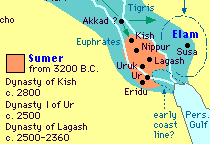Akkadians
History
 |
In 2,125 B.C.E., the Sumerian city of Ur in southern Mesopotamia rose up in revolt, and the Akkadian empire fell before a renewal of Sumerian city-states.
The Akkadians were Semites, that is, they spoke a language drawn from a family of languages called Semitic languages (the term "Semite" is a modern designation taken from the Hebrew Scriptures; Shem was a son of Noah and the nations descended from Shem are the Semites). These languages include Hebrew, Arabic, Assyrian, and Babylonian. After the final end of Sumerian power and civilization around 2,000 B.C.E., the area came under the exclusive control of Semitic peoples for centuries.
The epic of Atrahasis occurred in both oral and written forms (the oldest known copy from about 1,630 B.C.E), and described both the creation of humans and a great flood to destroy mankind, which stories share details with those described in other civilizations of the Mesopotamian area including the one in the Bible.
Excerpted and adapted from: Lambert, W. G., and A. R. Millard. 1999. Atra-Hasis. The Babylonian Story of the Flood. Originally published in 1969 by Oxford University Press., The Akkadians, The great Flood: the Epic of Atrahasis, Atra-Hasis